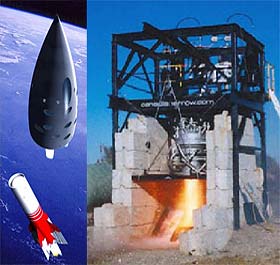PlanetSpace Canadian Arrow
The Canadian Arrow by PlanetSpace Corporation is based upon
the V2 rocket and is the first Canadian company to develop
a vehicle dedicated towards the space tourism industry. Based
in Ontario, PlanetSpace not only sees a future in hauling
up space tourists, but also is interested in initiating the
extreme sports of space diving.
 Canadian Arrow
Canadian Arrow |
|
Never accomplished before, the Canadian Arrow will be bringing
brave souls to the edge of suborbital space and then releasing
them from their capsule where they will jump and parachute
safely back to earth.
The Canadian Arrow is a 54-foot long, three-person rocket
that will hit suborbital heights and has two stages with an
escape system. The first stage of the craft makes up the majority
of the rocket at 33.5 feet long. It has four fins that lend
to aerodynamic stability on the base of the rocket.
The Canadian Arrow can be steered by using graphite jet vanes
and flaps on the fins that will turn the vehicle in the needed
direction. The second stage of the vehicle is where the passengers
will be. It is 20 feet long and has four JATO rocket engines
to add to propulsion.
These can be fired at any time, even when on the launch pad
for an abort. This stage has a reentry ballute as well as
three parachutes. The ballute, (like a large balloon), slows
down the passenger cabin and stabilizes it at the same time.
The parachutes will slow the cabin down to just 26 feet per
second, which will allow the cabin to splashdown safely.
When it is launch day, the Canadian Arrow will get to the
launch site about 4 hours before the launch time. The rocket
will be checked out and pre-launch set-up will commence. About
30 minutes prior to the launch, the passengers will enter
the cabin and get set up inside.
After being fueled with alcohol and liquid oxygen (cryogenically
cooled), the Canadian Arrow will then launch at the proposed
launch time. The first stage of the rocket will burn for about
a minute before exhausting all of the fuel.
At this point, the passengers will feel about 4.5 Gs of acceleration.
When the Canadian Arrow is at the very edge of space, the
two stages will separate and then second stage will start
it's rockets complete the trip of 60 - 70 miles up before
it begins it's decent to earth.
As the second stage re-enters the atmosphere, the ballute
will slow the passenger cabin until it is released and the
three parachutes are released. These will slow the Canadian
Arrow to a speed with which it will gently hit the water.
The cabin will then roll over until the hatches are pointed
up, due to its low center of gravity. Buoys are then blown
up, to make the second a raft in the water the passengers
can open the hatch to stand up while they wait for the recovery
team to pick them up.
Unlike NASA or other space tourism development companies,
PlanetSpace envisions these water landing to be fresh water
rather than salt water. Fresh water landing enable the capsule,
parachutes and ballute to be cleaned and dried within 24-hours
enabling another launch.
PlanetSpace does have an advantage over other budding space
tourism companies, however, in that they have signed a joint
information sharing agreement with NASA. Under the agreement,
NASA will share information to help the Canadian Arrow transport
passengers and cargo into low earth orbit.
Interested in a space flight on the Canadian Arrow? PlanetSpace
has announced that they will start taking reservations shortly.
Start saving now also since the expected price for space tourists
will be above the $100,000 mark.
|

